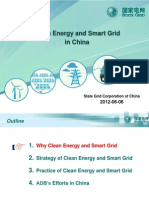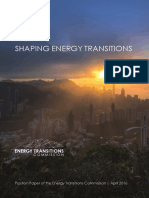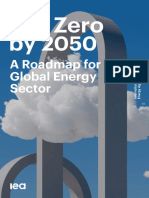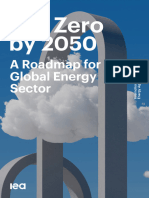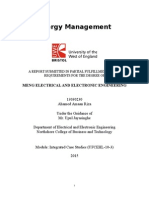India LCD Copenhagen Dec11
India LCD Copenhagen Dec11
Uploaded by
Ayush SharmaCopyright:
Available Formats
India LCD Copenhagen Dec11
India LCD Copenhagen Dec11
Uploaded by
Ayush SharmaCopyright
Available Formats
Share this document
Did you find this document useful?
Is this content inappropriate?
Copyright:
Available Formats
India LCD Copenhagen Dec11
India LCD Copenhagen Dec11
Uploaded by
Ayush SharmaCopyright:
Available Formats
Energy Intensive Energy-Intensive Sectors of the Indian Economy
Options for Low-Carbon Development (LCD) Low Carbon Preliminary Findings
PATHWAYS FOR LOW CARBON GROWTH IN DEVELOPING COUNTRIES Copenhagen, Denmark December 11, 2009
Indias Current Carbon Footprint
India i I di is among the top 10 emitters of CO2 th t itt f
due to the size of its economy and population, but per capita CO2 emissions from fuel combustion (2007)
India 1.2 tonnes vs. global average of 4.4 tonnes d 2 l b l f India one of 20 countries exhibiting successive decline over two subperiods
CO2 emission intensity of GDP (PPP) on par with global average
Indias development needs are massive:
400 million people who still lack access to electricity 456 million living at $1 25 a day (in 2005, U S dollars at PPP). $1.25 2005 U.S. PPP) 2007 electrical energy deficit of about 10 percent and peak shortages over 17 percent Two thirds of households rely on biomass for cooking One third of households rely on kerosene for lighting
Electricity supply is inadequate and unreliable
India Has a Scarcity of Clean and Primary Fuels
Current i t ll d capacity of 145 GW of which 77 GW (53 %) is coal-fired C t installed it f f hi h i l fi d India has plans to maximize all sources of renewable energy by 2032, and significantly increase the share of clean energy such as nuclear and solar
160000 140000 120000 100000 80000 60000 40000 20000 0 2.12 7000 16000 58 15000 2344 683 50000 5000 1033 45000
150000
36878 9755
Potential
Current Installed
source: Ministry of New and Renewable Energy and Integrated Energy Policy
Scenarios and Sensitivity Analyses
Scenario 1 FiveYearPlans AverageannualGDP growth20092031 Powersectorrepairand maintenance PowerSectorexpansion T&DLossreduction Demandsectors: Industry,Household, Nonresidential,Transport 7.6% Scenario2 Delayed Implementationof SupplyMeasures" 7.6% Asscenario1 Asperplans, historically adjusted 50%slippagein cleancoal,hydro, andrenewables Delayed5years Asscenario1 Scenario3 "AllOutStretch" 7.6% Enhancedprogram Additional20GW Solar and20GW imported Hydro Accelerated10years Additionalenergy efficiencymeasuresin each sector Asscenario3plus additionalcarbonneutral electricitycapacity
SensitivityAnalyses
Asscenario1but withreducedGDP growth(6.6%)
20%slippage
Total CO2 Emissions in Scenario 1 Findings Five Year Plans Scenario
In the five I th fi sectors, CO2e emissions increase from 1.1 billion t t i i i f 1 1 billi tonnes to 4.5 billion tonnes from 2007 to 2031; carbon intensity improves by 28 percent during the same period
Billiontonnes CO2 Billi 16% 29% 4% 51% 1%
5.0 4.5 4.0 3.5 3.0 2.5 2.0 1.5 1.0 0.5 0.0
2031 Gridsupplyelectricity Nonresidential Captivegeneration Roadtransport Industry
Total CO2 Emissions in Scenario 3 Findings All-out Stretch Scenario
Using technologies available on commercial basis as point of departure - lowest growth of CO2e emissions in the five sectors, increases from 1.1 to 3.7 billion tonnes from 2007 to 2031; carbon intensity improves by 41 percent during the same period
Billiontonnes CO2 16% 26% 5% 53%
4.0 3.5 3.0 2.5 2.0 1.5 1.0 10 0.5 0.0
2031
Captivegeneration Roadtransport Industry
Gridsupplyelectricity Nonresidential
Potential for Red cing Emissions fo Reducing
Implementing all the demand-side and supply-side I l i ll h d d id d l id measures in scenario 3 reduces emissions in 2031 by 815 million tonnes CO2
Scenario1 2,287 , 169 1,281 1 730 4,468 Scenario3 1,937 , 170 950 1 594 3,653 Decrease 350 0 330 0 136 815 %Decrease 15 0 26 0 19 18
Source Gridsupplyelectricity pp y y Captivegeneration Industry Nonresidential Roadtransport Total(in2031)
Preliminary Findings Power Sector
Grid l t i it G id electricity generated increases by 4.3 in scenario 1 and 3.9 in t di b 43i i d39i scenarios 2 and 3 Coal continues to dominate electricity generation 100 73% in Sc1 Generationfromcoal(%) 80 84% in Sc2 71% in Sc3 60
Scenario 1 40
Only drops to 38% when 132 GW of carbon-neutral capacity added
Scenario 2 Scenario 3 Scenario 3 sensitivity analysis
20 0
Preliminary Findings Power Sector
T&D l loss reduction d i
One of the most cost-effective means of improving power sector performance and reducing CO2 emissions Impact of pace of T&D Loss Reduction Program
ChangeinCO2 emissions in20072031 (milliontonnes) 568 248 1,392 Change20072031 (billion2007rupees)in investmentin 94 6 227
T&Dlossreduction implementation Acceleratedby10years Acceleratedby5years Delayedby5years
Delayed implementation, lowers capital expenditures implementation for grid by about 15 percent - if shortfall is supplied by greater captive
Emerging Conclusions and Implications on Growth
Vast expansion needs for power generation V i d f i
4 to 6 times 2007 levels by 2031 More than 5 times 2007 levels by 2031
Explosive growth in transport fuel needs as a natural consequence of income growth and greater availability and delivery of basic services Despite Indian consumption expected to remain frugal:
Richest third of urban households in 2031 consuming one third of the EU average current electricity consumption Per capita consumption of the industry products in 2030 no higher than per capita world production in 2006 Car ownership in 2031 of 86 / 1000, significantly lower than 300 765 / 1000 observed in most high-income countries today
Emerging Conclusions a d Implications o e g g Co c us o s and p cat o s on Development
Success f S factors f a l for lower-carbon development in all b d l i ll major sectors include:
Comprehensive and large-scale changes in investment, p g g , performance, and governance, particularly in the power sector Improvement in implementation achievement targets Strong coordination of institutions across all levels of governmentfederal, state, and municipal Enhanced performance of the relevant institutions Setting up a reliable monitoring and evaluation system one can anticipate even faster emissions growth over time compared to Scenario 2 where CO2e emissions increase from 1.1 billion tonnes to 4.7 billion tonnes from 2007 to 2031.
Without any of the above elements,
Emerging Conclusions and Implications on Transport
Mitigation i Mi i i is particularly difficult i l l diffi l
Due to low private vehicle ownership rates coupled with exploding urban populations and rapid economic growth How it is implemented today will lock India into development pathways that may be difficult to change Difficult but fundamental changes that transform land use and transit policies i li i Adoption of high fuel economy and tight local emission standards, critical for new vehicles
Transport infrastructures has long operational life
Mitigation requires
Emerging Conclusions a d Implications o C ea e g g Co c us o s and p cat o s on Clean Energy
The fi di Th findings in this study underscore the challenge of expanding i thi t d d th h ll f di energy access and meeting energy needs, at affordable costs, and with limited global environmental impact within the menu of technological options currently available Study does not allow making conclusive statements about the costs of achieving different future carbon trajectories
But h B t shows possibilities for significant improvements in energy ibiliti f i ifi ti t i efficiency in many sectors, with low or potentially negligible costs
Decision makers in India will have to carefully consider the costs, benefits and risks of different transformative cleaner-energy transformative options, notably
enhance regional trade in cleaner energy sources Deploy aggressively new and emerging carbon-neutral energy sources
Energy Intensive Energy-Intensive Sectors of the Indian Economy
Options for Low-Carbon Development (LCD) Low Carbon Preliminary Findings
PATHWAYS FOR LOW CARBON GROWTH IN DEVELOPING COUNTRIES Copenhagen, Denmark December 11, 2009
You might also like
- Solar Energy Proposal For Anderson High School100% (2)Solar Energy Proposal For Anderson High School10 pages
- Canadian Electrification Assessment Report - Embargoed CopyNo ratings yetCanadian Electrification Assessment Report - Embargoed Copy65 pages
- UN-DESA Policy Brief No. 24: Climate Change and The Energy ChallengeNo ratings yetUN-DESA Policy Brief No. 24: Climate Change and The Energy Challenge2 pages
- Overview of Indonesia's Energy Sector: Current Status & Development PlansNo ratings yetOverview of Indonesia's Energy Sector: Current Status & Development Plans35 pages
- Twin Peaks: Surmounting The Global Challenges of Energy For All and Greener, More Efficient Electricity ServicesNo ratings yetTwin Peaks: Surmounting The Global Challenges of Energy For All and Greener, More Efficient Electricity Services10 pages
- MECH5320M Print Compile Rev1 2or4 perpageNo ratings yetMECH5320M Print Compile Rev1 2or4 perpage70 pages
- Growing Energy Nedd and Mitigation Options in IndiaNo ratings yetGrowing Energy Nedd and Mitigation Options in India36 pages
- Session 5 - Sustainability and Circular EconomyNo ratings yetSession 5 - Sustainability and Circular Economy31 pages
- Modelling and Policy Analysis: Long-Term Power Options For IndiaNo ratings yetModelling and Policy Analysis: Long-Term Power Options For India51 pages
- Overcoming Barriers For The Scaling Up of EE Appliances in NigeriaNo ratings yetOvercoming Barriers For The Scaling Up of EE Appliances in Nigeria63 pages
- McKinsey Global Institute Report On Promoting Energy Efficiency in The Developing WorldNo ratings yetMcKinsey Global Institute Report On Promoting Energy Efficiency in The Developing World5 pages
- Renovation, Modernization and Life Extension of Power PlantsNo ratings yetRenovation, Modernization and Life Extension of Power Plants24 pages
- 1 Energy-RSDD by A. Zhou Final 20mar2013No ratings yet1 Energy-RSDD by A. Zhou Final 20mar201323 pages
- Electric Power Sector and Climate Change MitigationNo ratings yetElectric Power Sector and Climate Change Mitigation95 pages
- MEDA Initiative On Energy Conservation Act in Maharashtra: Hemantkumar H. PatilNo ratings yetMEDA Initiative On Energy Conservation Act in Maharashtra: Hemantkumar H. Patil59 pages
- China, India, and Brazil Now Represent Three of The Top 10 Energy Consuming Nations of The WorldNo ratings yetChina, India, and Brazil Now Represent Three of The Top 10 Energy Consuming Nations of The World40 pages
- Climate Action South Asia: Information Update No. 2 (Economics of Reducing Greenhouse Gas Emissions in South Asia)No ratings yetClimate Action South Asia: Information Update No. 2 (Economics of Reducing Greenhouse Gas Emissions in South Asia)8 pages
- Comparison of Historic Energy Projections and Current DataNo ratings yetComparison of Historic Energy Projections and Current Data7 pages
- Session 3 - Net Zero by 2050 - IEA - ReferenceNo ratings yetSession 3 - Net Zero by 2050 - IEA - Reference24 pages
- Colombia-UK PACT ToR Just Energy Transition v2No ratings yetColombia-UK PACT ToR Just Energy Transition v232 pages
- Energy Sector Development and Climate Mitigation: Ajay MathurNo ratings yetEnergy Sector Development and Climate Mitigation: Ajay Mathur9 pages
- GHG Emissions Factsheet Bangladesh - 4-28-16 - Edited - Rev08-18-2016 - CleanNo ratings yetGHG Emissions Factsheet Bangladesh - 4-28-16 - Edited - Rev08-18-2016 - Clean3 pages
- IEA - 2021 - Net Zero by 2050 - A Roadmap For The Global Energy SectorNo ratings yetIEA - 2021 - Net Zero by 2050 - A Roadmap For The Global Energy Sector19 pages
- Energy Efficiency in The Industry - Complement For Renewable Energies - Maria Holopainen VTTNo ratings yetEnergy Efficiency in The Industry - Complement For Renewable Energies - Maria Holopainen VTT33 pages
- Climatic Change 2. Advances in Renewable Energy 3. Rapid Urbanization 4. Battery Chemistry 5. Energy SecurityNo ratings yetClimatic Change 2. Advances in Renewable Energy 3. Rapid Urbanization 4. Battery Chemistry 5. Energy Security46 pages
- Carbon Efficiency, Carbon Reduction Potential, and Economic Development in the People's Republic of China: A Total Factor Production ModelFrom EverandCarbon Efficiency, Carbon Reduction Potential, and Economic Development in the People's Republic of China: A Total Factor Production ModelNo ratings yet
- Sixth Grade Lesson Plan - Heat Moves PDFNo ratings yetSixth Grade Lesson Plan - Heat Moves PDF4 pages
- Hans Bethe - Energy Production in StarsNo ratings yetHans Bethe - Energy Production in Stars20 pages
- Introduction To Chemistry: by Zaiba KhanNo ratings yetIntroduction To Chemistry: by Zaiba Khan25 pages
- Friday Lunchtime Lecture: Can Open Data Help Bring Us Clean, Local Energy?No ratings yetFriday Lunchtime Lecture: Can Open Data Help Bring Us Clean, Local Energy?15 pages
- Investment Opportunities in The Nigerian Power SectorNo ratings yetInvestment Opportunities in The Nigerian Power Sector39 pages
- Wei Yu Et Al - Direct Acceleration of Solid-Density Plasma Bunch by Ultraintense LaserNo ratings yetWei Yu Et Al - Direct Acceleration of Solid-Density Plasma Bunch by Ultraintense Laser6 pages
- Class 9 Fortunate 40 - Phase - 3 - Paper - 1 - PSM On 18.08.11No ratings yetClass 9 Fortunate 40 - Phase - 3 - Paper - 1 - PSM On 18.08.113 pages
- Mammalian Radiation Biology Course: Interaction of Radiation With Biological SystemsNo ratings yetMammalian Radiation Biology Course: Interaction of Radiation With Biological Systems46 pages
- Energy and Comfort Management in Energy Efficient Buildings Using RETSCREEN Software-A Case Study AnalysisNo ratings yetEnergy and Comfort Management in Energy Efficient Buildings Using RETSCREEN Software-A Case Study Analysis4 pages
- The University of The South Pacific: School of Engineering and PhysicsNo ratings yetThe University of The South Pacific: School of Engineering and Physics7 pages
- Energy Management: Meng Electrical and Electronic EngineeringNo ratings yetEnergy Management: Meng Electrical and Electronic Engineering14 pages
- A2 Physics Unit 4 Topic 3 Examzone AnswersNo ratings yetA2 Physics Unit 4 Topic 3 Examzone Answers2 pages
- Products - Battery Storage - Storage Battery SystemNo ratings yetProducts - Battery Storage - Storage Battery System6 pages
- Canadian Electrification Assessment Report - Embargoed CopyCanadian Electrification Assessment Report - Embargoed Copy
- UN-DESA Policy Brief No. 24: Climate Change and The Energy ChallengeUN-DESA Policy Brief No. 24: Climate Change and The Energy Challenge
- Overview of Indonesia's Energy Sector: Current Status & Development PlansOverview of Indonesia's Energy Sector: Current Status & Development Plans
- Twin Peaks: Surmounting The Global Challenges of Energy For All and Greener, More Efficient Electricity ServicesTwin Peaks: Surmounting The Global Challenges of Energy For All and Greener, More Efficient Electricity Services
- Growing Energy Nedd and Mitigation Options in IndiaGrowing Energy Nedd and Mitigation Options in India
- Modelling and Policy Analysis: Long-Term Power Options For IndiaModelling and Policy Analysis: Long-Term Power Options For India
- Overcoming Barriers For The Scaling Up of EE Appliances in NigeriaOvercoming Barriers For The Scaling Up of EE Appliances in Nigeria
- McKinsey Global Institute Report On Promoting Energy Efficiency in The Developing WorldMcKinsey Global Institute Report On Promoting Energy Efficiency in The Developing World
- Renovation, Modernization and Life Extension of Power PlantsRenovation, Modernization and Life Extension of Power Plants
- Electric Power Sector and Climate Change MitigationElectric Power Sector and Climate Change Mitigation
- MEDA Initiative On Energy Conservation Act in Maharashtra: Hemantkumar H. PatilMEDA Initiative On Energy Conservation Act in Maharashtra: Hemantkumar H. Patil
- China, India, and Brazil Now Represent Three of The Top 10 Energy Consuming Nations of The WorldChina, India, and Brazil Now Represent Three of The Top 10 Energy Consuming Nations of The World
- Climate Action South Asia: Information Update No. 2 (Economics of Reducing Greenhouse Gas Emissions in South Asia)Climate Action South Asia: Information Update No. 2 (Economics of Reducing Greenhouse Gas Emissions in South Asia)
- Comparison of Historic Energy Projections and Current DataComparison of Historic Energy Projections and Current Data
- Energy Sector Development and Climate Mitigation: Ajay MathurEnergy Sector Development and Climate Mitigation: Ajay Mathur
- GHG Emissions Factsheet Bangladesh - 4-28-16 - Edited - Rev08-18-2016 - CleanGHG Emissions Factsheet Bangladesh - 4-28-16 - Edited - Rev08-18-2016 - Clean
- IEA - 2021 - Net Zero by 2050 - A Roadmap For The Global Energy SectorIEA - 2021 - Net Zero by 2050 - A Roadmap For The Global Energy Sector
- Energy Efficiency in The Industry - Complement For Renewable Energies - Maria Holopainen VTTEnergy Efficiency in The Industry - Complement For Renewable Energies - Maria Holopainen VTT
- Climatic Change 2. Advances in Renewable Energy 3. Rapid Urbanization 4. Battery Chemistry 5. Energy SecurityClimatic Change 2. Advances in Renewable Energy 3. Rapid Urbanization 4. Battery Chemistry 5. Energy Security
- Carbon Efficiency, Carbon Reduction Potential, and Economic Development in the People's Republic of China: A Total Factor Production ModelFrom EverandCarbon Efficiency, Carbon Reduction Potential, and Economic Development in the People's Republic of China: A Total Factor Production Model
- Friday Lunchtime Lecture: Can Open Data Help Bring Us Clean, Local Energy?Friday Lunchtime Lecture: Can Open Data Help Bring Us Clean, Local Energy?
- Investment Opportunities in The Nigerian Power SectorInvestment Opportunities in The Nigerian Power Sector
- Wei Yu Et Al - Direct Acceleration of Solid-Density Plasma Bunch by Ultraintense LaserWei Yu Et Al - Direct Acceleration of Solid-Density Plasma Bunch by Ultraintense Laser
- Class 9 Fortunate 40 - Phase - 3 - Paper - 1 - PSM On 18.08.11Class 9 Fortunate 40 - Phase - 3 - Paper - 1 - PSM On 18.08.11
- Mammalian Radiation Biology Course: Interaction of Radiation With Biological SystemsMammalian Radiation Biology Course: Interaction of Radiation With Biological Systems
- Energy and Comfort Management in Energy Efficient Buildings Using RETSCREEN Software-A Case Study AnalysisEnergy and Comfort Management in Energy Efficient Buildings Using RETSCREEN Software-A Case Study Analysis
- The University of The South Pacific: School of Engineering and PhysicsThe University of The South Pacific: School of Engineering and Physics
- Energy Management: Meng Electrical and Electronic EngineeringEnergy Management: Meng Electrical and Electronic Engineering
- Products - Battery Storage - Storage Battery SystemProducts - Battery Storage - Storage Battery System













